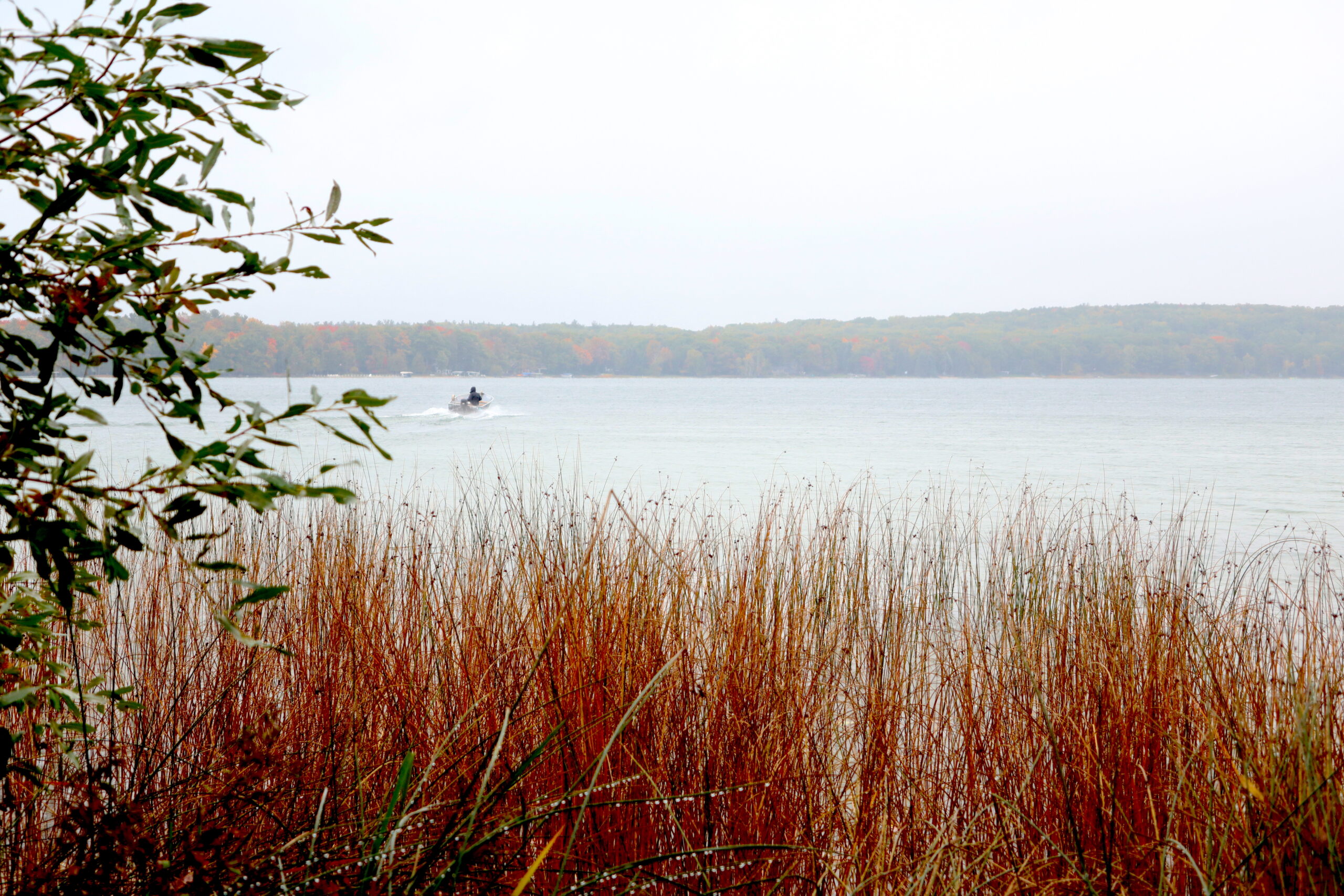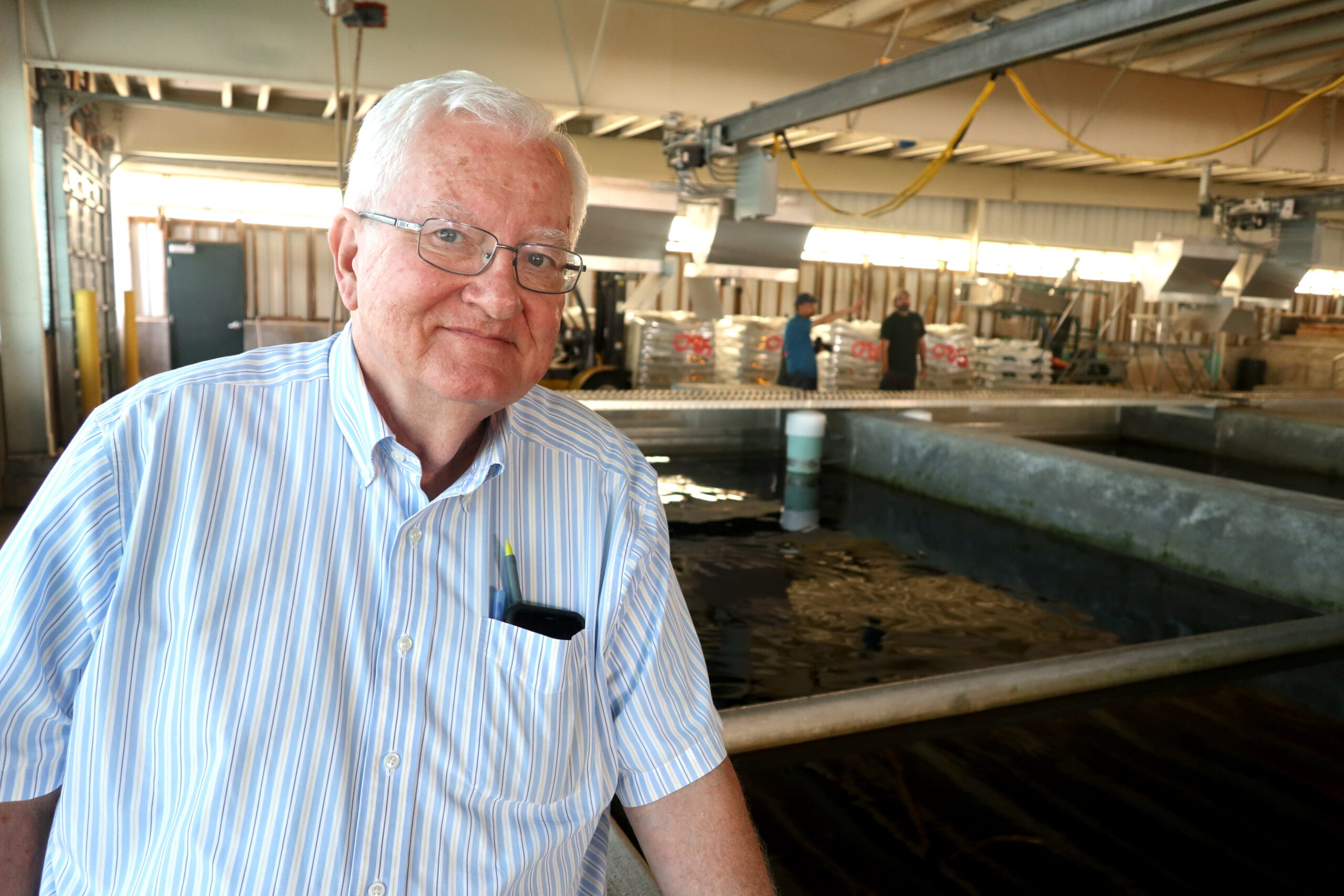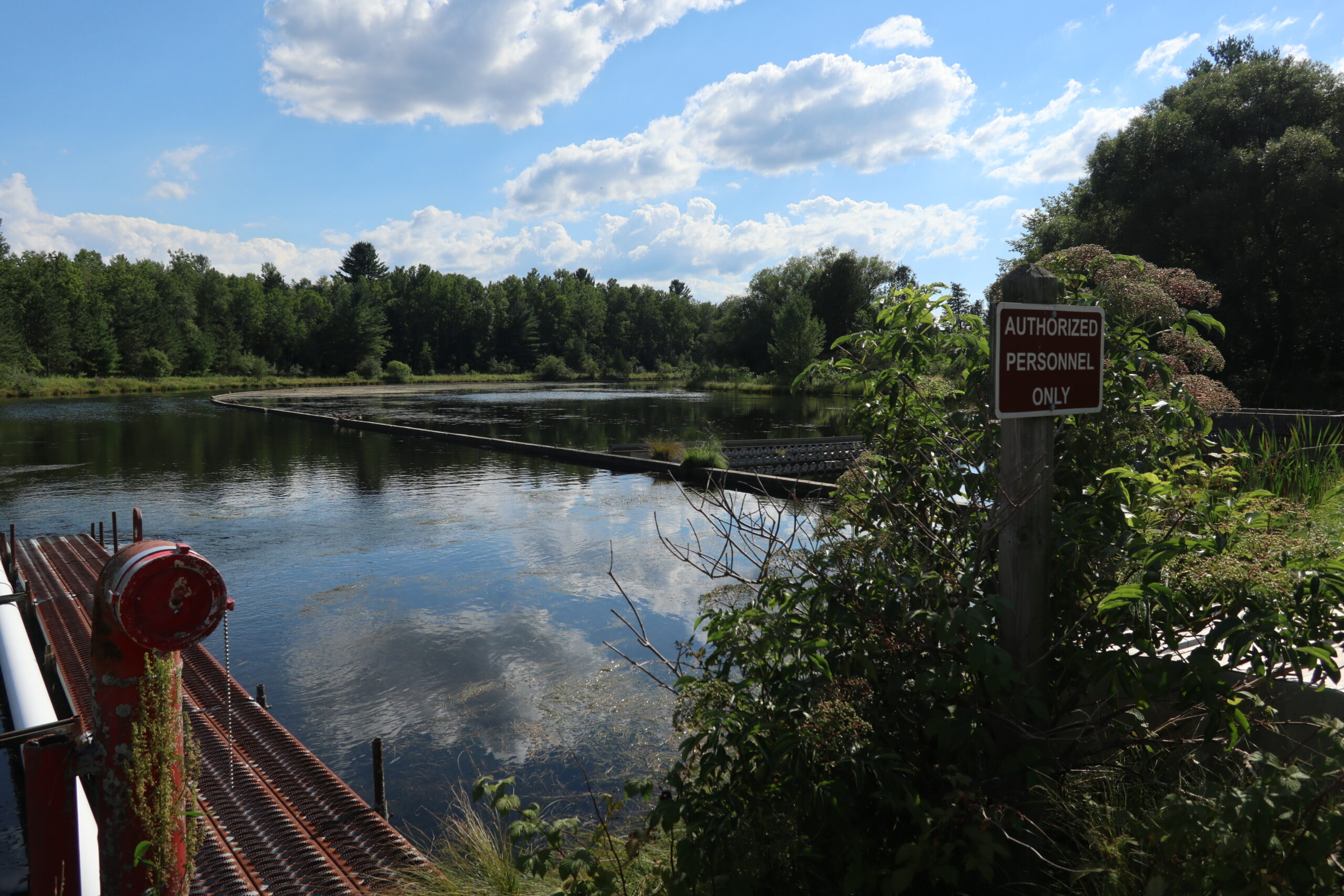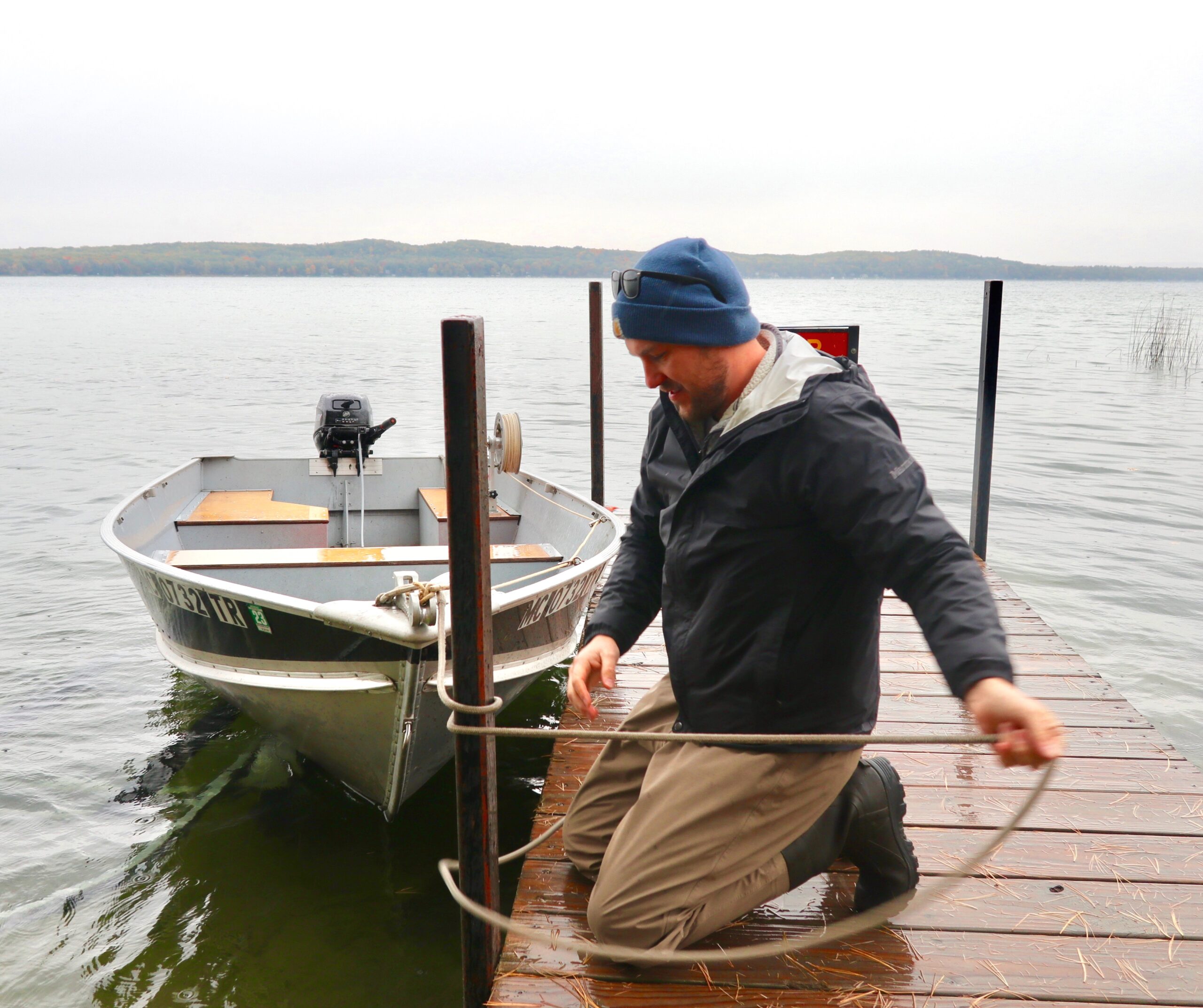
Platte Lake’s condition has been restored. (Photo/Keith Schneider)
HONOR — On a bright autumn afternoon Platte Lake is a stirring statement about the excellent condition of Benzie County’s natural resources. Its broad waters are stunning alpine blue. Its shoreline brims with the splendor of maple leaves, a fluttering hoard of yellow, orange, and red.
But more than the fortunate convergence of thick forest and fresh water is at play on and around the 2,500-acre lake. The commanding beauty also is the result of years of work by shoreline residents, scientists, lawyers, and government officials to clear the waters of phosphorus pollution that for four decades generated the dangerous and unsightly green-blue swirls of toxic algae blooms.
Harmful algal blooms menace rivers, fresh water lakes, and seashores almost everywhere in the U.S. and around the world. They are caused by excess phosphorus draining from land. For many reasons, toxic blooms are difficult to cure. Platte Lake is the only major water body in Michigan, and one of the very few across the country, where harmful algal blooms were solved in this century.
The effort by the Platte Lake Improvement Association, little known in or outside Benzie County, was started by its former president 48 years ago. It relied on a powerful state environmental law to halt ecological damage. The court victory eventually cleared algae from the lake, and established valuable legal principles.
There’s more. Preparations for trial and years of negotiations afterward produced a state-of-the-art water quality monitoring program in the lake’s 192 square-mile watershed to identify and block other nutrient discharges. A contract to manage water sampling sites strengthened the finances of the Benzie Conservation District. Lake Township banned lawn fertilizers in 2005 that contain phosphorus. The Benzie County Road Commission stopped spreading fertilizer in 2015 that contains phosphorus on its maintenance projects near waterways.
“The solution to environmental and public health problems of this magnitude can’t be resolved by media campaigns and public meetings,” said James Olson, a prominent Michigan environmental lawyer and legal advisor to the Platte Lake campaign. “You have to get the stakeholders to the table under the compulsion of law. In the Platte Lake case the Michigan Environmental Protection Act and the public trust doctrine produced changes in practice that restored the lake.”

Every great story has a start. The work to end Platte Lake’s algal bloom began in 1974 when 27 year-old Wilfred Swiecki invited his Maltese-born fiance’ to join him at the family cottage on Platte Lake. Though he’d been away for several years pursuing degrees in engineering, Swiecki anticipated showing her the same magnificent Benzie County lake of his boyhood summers – waters teeming with bass and pike and so clear the deep lake bottom was plainly visible.
Swiecki’s return was a shock. Lake waters were green and filmy with algae. Swirls of blue-green algae and ugly algae mats floated on the surface. The air carried the scent of decay. “I couldn’t see my toes in three feet of water,” Swiecki recalled in an interview. ” said, ˜This is crazy.’ So I really got into it.”
An expert researcher, Swiecki spent months reading records at the State Archives and other information repositories in Lansing. He learned that even minute increases in phosphorus above natural background levels can lead to toxic algal blooms. Swiecki’s research identified what turned out to be the primary source of phosphorus in the Platte Lake watershed – the Platte River State Fish Hatchery, eight miles upstream.
Built in 1928 to raise trout, the hatchery did its job for nearly half a century while attracting scant attention from downstream residents. In 1964, though, the Michigan Department of Natural Resources, the hatchery’s owner and operator, began raising Pacific salmon for a new Lake Michigan fishery. The first hatchlings were released into the Platte River in 1966.
Swiecki discovered that DNR managers fed fry and hatchlings fish pellets with elevated concentrations of phosphorus. As salmon production increased so did the amount of fish food, and discharges of phosphorus. By 1970, the Platte River hatchery helped Michigan raise and stock 2 million salmon a year in Lake Michigan. By 1976 production had doubled, according to state figures.
Swiecki calculated that by the late 1970s, as it neared peak production, the hatchery used 450,000 pounds of high-phosphorus feed annually and released over 4,300 pounds of phosphorus into the Platte River. The consequence was big, ugly, and dangerous toxic algal blooms that developed every summer in the lake downstream.
In 1981 Swiecki was named president of the then three-year-old lake association, a position he held for the next 40 years. Having discovered the cause, Swiecki rallied the association’s members to consider an appropriate response. Their options were limited and fraught with some personal risk.
The Lake Michigan salmon fishery was a smash with fishermen, who stood shoulder to shoulder in the fall along the Platte and other Lake Michigan rivers casting into waters thick with huge fish. Fishing associations joined charter captains and allied hotel and recreation groups to actively support the DNR’s new fishery. They made it clear to Swiecki that changing the DNR’s production practices, which they feared would lower the catch, was not appreciated.
Swiecki and his allies were undeterred. They prepared for a legal fight. Swiecki turned for help to Jim Olson and Frederick Dilley, two of the state’s top environmental lawyers, and to Dr. Raymond P. Canale, a University of Michigan aquatic ecosystems specialist.

to the Platte Lake Improvement Association. (Photo/Keith Schneider)
Olson and Dilley outlined the evidence needed to make the association’s case. That included a scientifically firm calculation of how much phosphorus the DNR would need to remove from its production process. Dr. Canale concluded that in order to cure toxic blooms phosphorus concentrations in Platte Lake waters could be no higher than 6 to 7 parts per million. That meant that the DNR would need to cut its phosphorus discharge from the hatchery from 4,300 pounds to 150 pounds per year. The Lake Association sought to establish that limit in the hatchery’s wastewater discharge permit.
The DNR refused to accept the change. In 1986, the lake association brought suit against the agency under the Michigan Environmental Protection Act, the most powerful state environmental law in the U.S. MEPA, as its commonly known, gives citizens and state courts the authority to prevent conduct that causes “pollution, impairment, or destruction” unless “there is no feasible and prudent alternative.”
The Platte Lake Improvement Association proved the hatchery was the primary polluter. Phosphorus was the offending pollutant that caused the lake’s severe impairment and destruction. Lastly, the association showed the Platte River hatchery had feasible and prudent alternatives, like changing to a low-phosphorus brand of fish food, and adding waste water treatment infrastructure that dramatically reduced phosphorus discharges.
After a four-day bench trial, Circuit Court Judge Thomas Brown issued a ruling in 1988 in the association’s favor. He ordered the DNR to halt discharges of excess phosphorus and obey the law.
The DNR resisted. Several times the state agency was held in contempt for violating Judge Brown’s decision. Swiecki regularly traveled to Lansing to negotiate with the agency, and appeal to lawmakers for help. One of the lawmakers he talked to was John Engler, the Republican Senate majority leader, who seemed sympathetic.
It took 12 more years, though, for the association and the state agency to reach agreement on provisions of a consent order to make the needed changes in hatchery operations, including a $8.5 million renovation and installation of a wastewater treatment system. In 2000, when the agency turned to the Legislature with its budget request Engler, then the governor, intervened.
“Engler told the DNR I’m not going to give you 10 cents until you settle that lawsuit with the Platte Lake Association,” Swiecki said. “They settled.”

phosphorus discharges from the Platte River State Fish Hatchery. (Photo/Keith Schneider)
Swiecki also credits Gary Whelan, a DNR fish biologist, who worked for months with Swiecki and John Spencer, another Lake Association leader, to negotiate the details of the settlement. It’s been amended four times. “Ours is an ongoing consent judgement with the DNR,” Swiecki said. “As long as we maintain a viable organization, that consent judgement continues. There’s a dispute resolution process. There’s a penalty fund if there are violations.”
The hatchery changed fish food and agreed to the 150 pound annual limit for phosphorus discharges. The DNR finished the hatchery renovations in 2005. The agreement, a compromise, set eight parts per million as the upper limit for phosphorus concentrations in Platte Lake. By 2010 harmful algal blooms had receded.
“You can see the difference in the lake,” Swiecki said. “When I was a kid you could drop a newspaper in 10 feet of water and see the headlines. It was clear. Really clear. We’re getting closer to that kind of clarity now.”
The state also agreed to assume much of the cost of installing and managing the watershed sampling program to assure the DNR complies with the consent order. In 2010, the Benzie Conservation District took over the sampling program under contract to the lake association. In 2015, the year John Ransom, the district’s biologist, began collecting samples every two weeks from nine locations on the lake, the Platte River, and several streams, the Lake Association has assumed all of the sampling and monitoring costs.
Analyzed at the fish hatchery, measurements are recorded for concentrations of phosphorus, dissolved oxygen, water clarity and other basic data points. The oversight program is so sensitive that when unusually high concentrations of phosphorus appeared in the Platte River in 2013 upstream of the hatchery, the lake association tracked the discharge to a farm field off Highway 669. The Packaging Corporation of America was using the field to spread biosolid wastes from its plant in Manistee. The Lake Association convinced the company to halt the practice.
Citizen-led watershed sampling programs are rare in Michigan and across the country. The Platte Lake program is one of the best. Water quality data collected since the late 1980s is digitized and is available on an online Plattelake.org dashboard designed by Ray Canale and maintained by the association and the conservation district. “It has a lot of capability,” said Ransom, who was raised near Lake Ann.

Plate Lake’s recovery is one of a steadily expanding number of environmental achievements in Benzie County since the first Earth Day in 1970. Few rural counties in Michigan, or the nation, have more powerfully embraced the responsibility to safeguard natural resources over the last 52 years.
Sleeping Bear Dunes National Lakeshore, one of 3 Great Lakes national lakeshores and one of 14 national lakeshores and seashores across the country, was established in 1971. The Betsie River was declared a natural river in 1973, one of 16 in the state. The county’s magnificent dunes and ample wetlands have been protected by state law since the early 1970s. Betsie Bay recovered from years of sewage and industrial pollutants due to the 1972 federal clean water law and state enforcement. There are 20 nature preserves developed in Benzie County by the Grand Traverse Regional Land Conservancy since the early 1990s, including the 3,800-acre Arcadia Dunes preserve along Lake Michigan in Joyfield Township. In 1990, the county approved Michigan’s first health ordinance requiring septic systems to be inspected prior to home sales. In 2010, Benzie voters approved a small property tax increase to raise $120,000 annually to support the Benzie Conservation District.
That vote led directly to the newest environmental achievement. In collaboration with the Benzie Conservation District, Beulah was awarded a $490,000 grant to design and improve drainage networks, construct storage basins, and filters to prevent E.coli, the dangerous intestinal bacteria, from reaching Crystal Lake. Beulah was eligible for the grant from the state Department of Environment, Great Lakes, and Energy because of the work Tad Peacock and his staff put in to establish a state-approved Crystal Lake watershed management plan, one of three such watershed plans in effect in Benzie County. The others encompass Upper and Lower Herring lakes, and Platte Lake.
“We have beach closings here a couple of times a year,” said Peacock, the district’s director since 2008. “We worked with the village to get this grant. Construction starts next spring.”
In its simplest explanation, Platte Lake’s recovery is a story of citizen activists who refused to be deterred. They relied on a lawsuit, peerless science, their own finances, and unyielding persistence to build a rare model — in Michigan and across the nation — for solving harmful algal blooms and ensuring they don’t return.
Platte Lake’s recovery also is a useful reference. It provides irrefutable evidence that ending harmful blooms is possible. Just as relevant, it reveals how difficult achieving that goal is, how much it can cost, and how long it can take. As Swiecki and his partners learned, there is no mystery to solving harmful algal blooms. It is essential to stop phosphorus from reaching streams, rivers, and lakes.
“You realize,” he added. “I was a young man when this started.”
In August, Wilfred Swiecki celebrated his 75thbirthday.
Versions of this article appeared in the Betsie Current and as part of a six-article series on harmful algal blooms published by Circle of Blue.
— Keith Schneider
For a comprehensive and fact filled assessment of the causes, impediments, and solutions to harmful algal blooms see Circle of Blue’s project — Danger Looms Where Toxic Algae Blooms.
I. Danger Looms Where Toxic Algae Blooms
II. Farms in Six Southeast Michigan Counties Are Major Sources of Lake Erie Toxic Blooms
III. In A Year of Water Quality Reckoning, National Imperative is Impeded
IV. Lake Erie’s Failed Algae Strategy Hurts Poor Communities the Most
V. Powerful Industry’s Torrent of Manure Overwhelms State Regulators
VI. Remedies for Harmful Algal Blooms Are Available in Law and Practice


Thank you, Will, Sweike, for all of your good work on our lake!